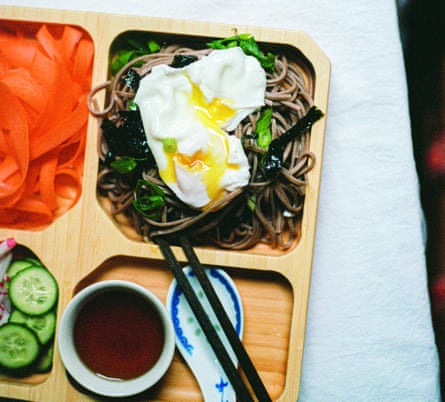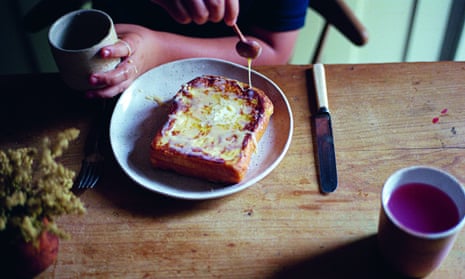Growing up, I didn’t understand my mother’s elaborate morning feasts. I was not always comfortable with my identity. Even though I was born in Australia, I didn’t feel particularly Australian, or Chinese for that matter.
After I started cooking in earnest, everything clicked into place. The more I cooked, the more connected I felt to my mother and her cultural heritage. The way I cook is, in many ways, third-culture cooking, a cross-pollination of ideas and techniques that are grounded in my Chinese heritage, yet greatly influenced by growing up in the western world. It is not distinctly Chinese, nor Australian, but rather a third interpretation of the two cultures.
In western culture, you most likely start the day with a light meal of cereal, porridge, toast or eggs. As I got older and spent more time in Asia, I realised that the grand breakfast was a big part of Asian culture. There is no holding back. When the day begins, it’s game on.
Condensed milk French toast
Serves 1
Hong Kong–style French toast is a cha chaan teng (tea restaurant) specialty – thick white bread spread with sweetened condensed milk and topped with even more of the sticky sweet milk. Growing up, my mother always kept a little jug of condensed milk in the fridge (later, she introduced the tube of condensed milk, which became a permanent fixture in her fridge door), which she would drizzle on toast for breakfast. I remember being intrigued by her morning ritual, and for many years, I thought sweetened condensed milk toast was her own personal quirk. Visiting Hong Kong again after decades of absence opened my eyes to many things, one of them being that my mum’s affection for milky sandwiches is actually a Hong Kong breakfast tradition.
2 thick slices of white bread
2–3 tbsp sweetened condensed milk
1 large egg
Salted butter, for pan-frying and to serve
Place the bread on a chopping board and drizzle one slice with about 1 tablespoon of the sweetened condensed milk. Sandwich the bread together.
Crack the egg into a bowl (large enough to fit the sandwich) and beat well. Dip the sandwich into the beaten egg, turning to coat both sides; allow the bread to sit in the egg until it soaks it all up.
Heat a small frying pan over medium heat, add a knob of butter and swirl it around to coat the base. Add the eggy sandwich and pan-fry on one side for a minute or so until golden, then flip over and repeat on the other side. Remove from the pan and place straight on a serving plate. Top with a knob of butter and drizzle with the remaining condensed milk. Allow the butter to melt over the bread and eat immediately.
Soba breakfast platter
Serves 4
As the sun rises in Tokyo, locals file into tiny restaurants for their morning noodles, slurping shoulder to shoulder. All kinds of noodle dishes are eaten for breakfast in Japan, but soba is a favourite, served either hot or cold, sometimes topped with tempura, grilled fish cakes or onsen tamago (soft-boiled egg).
This recipe is inspired by the morning soba noodle ritual we came across in Tokyo – a seiro (bamboo tray) of cold soba noodles (best eaten this way to experience the true texture, flavour and aroma of the buckwheat), served with a dipping sauce and condiments on the side.

For the noodles
400g soba noodles
Drop of white vinegar
4 large eggs
4 radishes, julienned
1 carrot, peeled into thin strips or shredded
2 Lebanese cucumbers, sliced into thin discs
2 sheets of toasted nori, sliced into strips
2 shallots, finely sliced
Sea salt
For the dipping sauce
250ml vegetable stock
2 tbsp tamari or soy sauce
3 tbsp mirin
1 tsp sugar
Substitutions
Soba: udon or somen noodles
Gluten free: use 100% buckwheat soba noodles, rice vermicelli or glass noodles
Veganise
Omit the egg
For the dipping sauce, combine all the ingredients in a small saucepan over medium heat. Bring to a gentle boil, stirring, then remove from the heat and set aside to cool.
Bring a saucepan of salted water to the boil, add the soba noodles and cook according to the packet instructions until al dente, about four to five minutes. Drain immediately and refresh under cold running water. (Alternatively, drain the noodles and place them in an ice bath.)
When completely cold, drain again.
In a saucepan of simmering water, add a drop of vinegar. Break one egg into a small bowl and gently ease it into the water. Cook for two minutes, until the white is just firm. If you prefer your yolk firmer, cook for another minute or two. Using a slotted spoon, transfer the egg to a plate lined with paper towel and allow to drain. Repeat with the remaining eggs.
Place a mound of noodles onto each serving plate and add the eggs, vegetables, nori and shallot alongside. Season the noodles and eggs with a pinch of sea salt. Pour the dipping sauce into little bowls and serve with the noodle platter.
Note: You can eat this dish as you wish – you could pour the dipping sauce over the noodles and veggies and eat it like a cold soup, or you could lift cold soba noodles and veggies, one mouthful at a time, and dip them into the sauce, slurping them up quickly.
Miso oats with egg and avocado
Serves 2
I learned to make this dish as a teenager, when my mum was laid up with back problems, leaving me as the primary cook in the house.
I’d never made congee before so my mother talked me through how to make savoury oats instead. I was instantly charmed by this quick and simple way of replicating congee, in a fraction of the time.
This is now my lunch-for-one staple, swiftly thrown together and topped with an egg, avocado, kimchi or even leftover salad. Drizzle with seasoning oil or your favourite hot sauce if you like it spicy.

100g old-fashioned rolled oats
1L vegetable stock
2 tbsp white (shiro) miso
4 large eggs
4 shallots, finely sliced
1 avocado, sliced
1–2 tbsp toasted black or white sesame seeds
Sea salt
Substitutions
Old-fashioned rolled oats: steel-cut oats
Boiled eggs: fried eggs
Gluten free: use gluten-free oats
Veganise
Omit the egg
Place the oats in a saucepan, add the stock and bring to the boil. Reduce the heat to low and place the lid on slightly ajar, then cook for about 15 minutes, until the oats have reached a porridge consistency. Turn off the heat and gradually stir in the miso paste, a little at a time, until it has dissolved into the oats. Taste and season with salt if needed.
Bring a saucepan of water to the boil, then add the eggs. Set the timer for six minutes for soft yolks, seven minutes for ‘jammy’ eggs and eight to nine minutes for hard-boiled eggs. When your timer goes off, drain the eggs immediately and either rinse them under cold running water or place in an ice bath until they are completely cold. Peel and cut in half.
Ladle the oats into bowls and top with the boiled eggs, shallot, avocado and sesame seeds. Season with a small pinch of sea salt and serve immediately.

This is an edited extract from To Asia, With Love by Hetty McKinnon available now through Pan MacMillan.

Comments (…)
Sign in or create your Guardian account to join the discussion